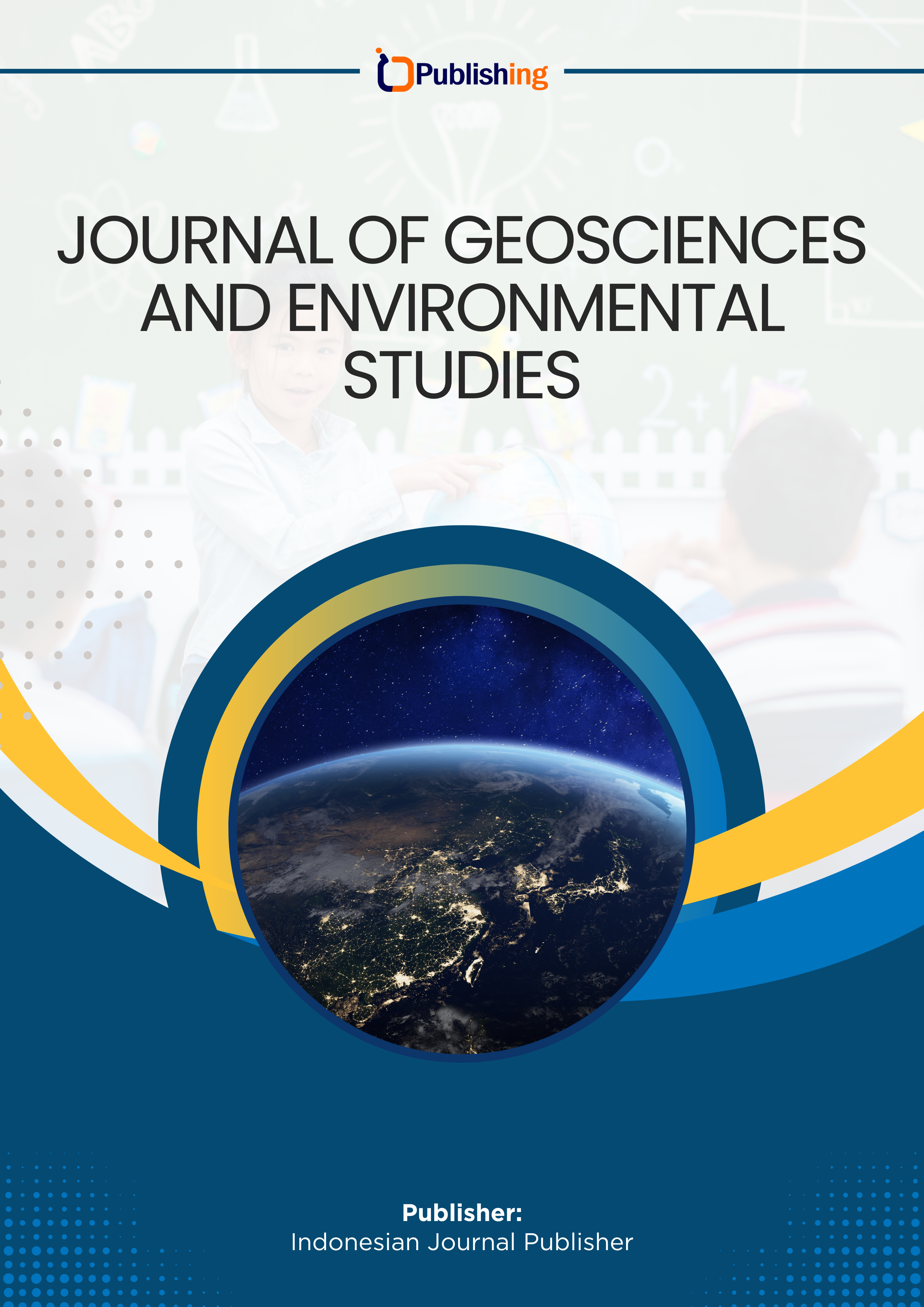Mapping of Food Supply Ecosystem Services in Malang Regency
DOI:
https://doi.org/10.53697/ijgaes.v2i2.3831Keywords:
Ecosystem Services, Food Supply, MalangAbstract
The increase in population is in line with the increase in resource use, including the need for land as a space for human activities to meet their needs. Land conversion, primarily agricultural land, into non-agricultural land can reduce the ability of land ecosystems to provide food. This research aims to assess the performance of ecosystem services for providing rice food in Malang Regency. The study used the Simple Additive Weighting (SAW) method, a simple weighting and scoring method of land use parameters, landform ecoregions, natural vegetation types, soil types, and rainfall to determine ecosystem services for food provision. The results showed that the Malang Regency area consists of 5 classes of Ecosystem Service Performance Index (ESPI) for rice food providers, including Very High, High, Medium, Low, and Very Low. The Medium class is the ESPI class with the highest area of 117,452.85 hectares or 34% of the total area. Followed by Low ESPI class 99,980.31 hectares (29%), High ESPI class 90,742.14 hectares (26%), Very Low ESPI class 19,191.28 hectares (6%), and Very High ESPI class 17,442.59 (5%).
References
Aprildahani Baiq Rindang, Abdul Wahid Hasyim, dan T. A. R. (2014). Alih Fungsi Lahan Pertanian di Kawasan Perkotaan Karangplsoso, Kabupaten Malang sebagai Dampak dari Urban Sprawl. Jurnal Pembangunan Dan Alam Lestari, 5(2). https://jpal.ub.ac.id/index.php/jpal/article/view/170
Costanza R., D’arge R., De Groot R., Farber S., Grasso M., Hannon B., Limburg K., Naeem S., O’neill R.V., Paruelo J., Raskin R.G., Sutton P., V. D. B. M. (1998). The Value of The World’s Ecosystem Services and Natural Capital. Ecological Economics, 25(1), 3–15. https://doi.org/10.1038/387253a0
Cumming Graeme S., Andreas Buerkert, Ellen M. Hoffmann, Eva Schlecht, Stephan von Cramon-Taubadel, T. T. (2014). Implications of agricultural transitions and urbanization for ecosystem services. Nature, 515(7525), 50–57. https://doi.org/10.1038/nature13945
Dade Marie C, Matthew G.E. Mitchell, Clive A. McAlpine, J. R. R. (2019). Assessing ecosystem service trade-offs and synergies: A more mechanistic approach is needed. Ambio, 48, 1116–1128. https://doi.org/10.1007/s13280-018-1127-7
Direktorat Pencegahan Dampak Lingkungan Kebijakan Wilayah dan Sektor. (2019). Buku Pedoman Daya Dukung dan Daya Tampung Lingkungan Hidup Daerah. Kementerian Lingkungan Hidup Dan Kehutanan, 1, 1–185. http://bumibaru.id/wp-content/uploads/2020/04/Pedoman-Penyusunan-DDDTLH-di-Daerah_Okt-2019.pdf
Du, L., Dong, C., Kang, X., Qian, X., & Gu, L. (2023). Spatiotemporal evolution of land cover changes and landscape ecological risk assessment in the Yellow River Basin, 2015–2020. Journal of Environmental Management, 332(28), 117149. https://doi.org/10.1016/j.jenvman.2022.117149
Febriarta, E., & Oktama, R. (2020). Pemetaan Daya Dukung Lingkungan Berbasis Jasa Ekosistem Penyedia Pangan Dan Air Bersih Di Kota Pekalongan. Jurnal Ilmu Lingkungan, 18(2), 283–289. https://doi.org/10.14710/jil.18.2.283-289
Hardjowigeno, S., Subagyo, H., & Rayes, M. L. (2004). Morfologi Dan Klasifikasi Tanah Sawah. Bahan Kuliah DTPT Ilmu Tanah, 27. https://www.academia.edu/download/30448253/tanahsawah1.pdf
Hidayat, S. I., & Rofiqoh, L. L. (2020). Analisis Alih Fungsi Lahan Pertanian Di Kabupaten Kediri. Jurnal Social Economic of Agriculture, 9(1), 59. https://doi.org/10.26418/j.sea.v9i1.40646
Holik, A., Bachtiar, R. R., & Halil, H. (2022). Pemetaan Daya Dukung Jasa Ekosistem Penyedia Pangan di Kabupaten Banyuwangi. Jurnal Keteknikan Pertanian Tropis Dan Biosistem, 10(3), 181–190. https://doi.org/10.21776/ub.jsal.2022.010.03.02
K. Paul Yoon, C.-L. H. (1995). Multiple attribute decision making: an introduction. Sage Publication. https://doi.org/10.1007/978-3-642-48318-9
Kartawinata, K. (2016). Diversitas ekosistem alami Indonesia: Ungkapan singkat dengan sajian foto dan gambar. LIPI Press dan Yayasan Pustaka Obor Indonesia.
Kawirian Ahmad Mahmdud, Hindarti, S., & Machfudz, M. (2020). Analisis Faktor-Faktor Sosial Ekonomi Yang Mempengaruhi Keputusan Petani Melakukan Alih Fungsi Lahan Dari Sektor Pertanian Ke Sektor Non Pertanian Di Desa Karangwidoro Kecamatan Dau Kabupaten Malang. Jurnal Sosial Ekonomi Pertanian Dan Agribisnis, 8(1). https://jim.unisma.ac.id/index.php/SEAGRI/article/view/6188/13750
Kurniawan Andri, M. I. S. (2018). Keistimewaan Lingkungan Daerah Istimewa Yogyakarta.
Kurniawan. (2018). Kajian Daya Dukung Lingkungan Jasa Penyedia Bahan Pangan di Kabupaten Gunungkidul Dengan Menggunakan Jasa Ekosistem. Gadjah Mada University.
Kusumadewi, S., Hartati, S., Harjoko, A., & Wardoyo, R. (2006). Fuzzy multi-attribute decision making (fuzzy madm). Graha Ilmu.
Maynard Simone, David James, A. D. (2010). The development of an ecosystem services framework for South East Queensland. Environmental Management, 45, 881–895. https://doi.org/10.1007/s00267-010-9428-z
Millennium Ecosystem Assessment (MEA). (2005). Ecosystems and human well-being (Vol. 5). https://www.unioviedo.es/ranadon/Ricardo_Anadon/docencia/DoctoradoEconomia/MilleniumEcoAssesment05OpporBusinessIndustry.pdf
Muta’ali Lutfi. (2015). Teknik analisis regional untuk perencanaan wilayah tata ruang dan lingkungan. Badan Penerebit Fakultas Geografi UGM.
Muta’ali Lutfi. (2019). Daya Dukung dan Daya Tampung Lingkungan Hidup Berbasis Jasa Ekosistem untuk Perencanaan Lingkungan Hidup. Badan Penerebit Fakultas Geografi UGM.
Nugroho, J., Zid, M., & Miarsyah, M. (2020). Potensi sumber air dan kearifan masyarakat dalam menghadapi risiko kekeringan di wilayah karst (Kabupaten Gunung Kidul, Provinsi Yogyakarta). Jurnal Pengelolaan Lingkungan Berkelanjutan (Journal of Environmental Sustainability Management), 4(1), 438–447. https://doi.org/10.36813/jplb.4.1.438-447
Poespowardoyo, R. S. (1984). Peta Hidrogeologi Indonesia Skala 1:250.000 Lembar X – Kediri.
Ramadhani Suci, R. Wi. (2024). Analisis Daya Dukung Lingkungan untuk Jasa Penyediaan Pangan Berbasis Jasa Ekosistem di Kota Padang. Jurnal Buana, 8(2), 443–456. https://doi.org/10.24036/buana/vol8-iss2/3535
Ruminta, Handoko, dan T. N. (2018). Indikasi perubahan iklim dan dampaknya terhadap produksi padi di Indonesia (Studi kasus: Sumatera Selatan dan Malang Raya). Jurnal Agro, 5(1). https://doi.org/10.15575/1607
Sabila, S. (2020). Daya Dukung Pangan Dalam Mendukung Ketersediaan Pangan Provinsi Sumatera Selatan. Jurnal Tanah Dan Sumberdaya Lahan, 7(1), 59–68. https://doi.org/10.21776/ub.jtsl.2020.007.1.8
Samsi, N., Wiryani, F., & Anggraeny, I. (2022). Pengawasan Terhadap Alih Fungsi Lahan Pertanian Menjadi Kafe. Indonesia Law Reform Journal, 2(1), 18–31. https://doi.org/10.22219/ilrej.v2i1.20392
Sasongko, P. E. (2023). Evaluasi Kesuburan Tanah dan Derajat Humifikasi pada Berbagai Tipe Penggunaan Lahan di Lereng Barat Gunung Bromo [Universitas Sebelas Maret]. https://digilib.uns.ac.id/dokumen/detail/100029/
Septory, J. S. I., Latue, P. C., & Rakuasa, H. (2023). Model Dinamika Spasial Perubahan Tutupan Lahan dan Daya Dukung Lahan Permukiman Kota Ambon Tahun 2031. In GEOGRAPHIA : Jurnal Pendidikan dan Penelitian Geografi (Vol. 4, Issue 1, pp. 51–62). https://doi.org/10.53682/gjppg.v4i1.5801
Triantaphyllou, E. (2000). Chapter 2 MULTI-CRITERIA DECISION MAKING METHODS 2.1. Springer, 44, 5–21. https://doi.org/10.1007/978-1-4757-3157-6_2
Wang, J., Zhou, W., Pickett, S. T. A., Yu, W., & Li, W. (2019). A multiscale analysis of urbanization effects on ecosystem services supply in an urban megaregion. Science of the Total Environment, 662, 824–833. https://doi.org/10.1016/j.scitotenv.2019.01.260
Yudhistira, A. (2024). Penerapan Metode Simple Additive Weighting dan Pembobotan Entropy Untuk Penentuan Teknisi Terbaik. 2(3), 143–152. https://doi.org/10.58602/jaiti.v2i3.133
Zou, L., Liu, Y., Wang, J., & Yang, Y. (2021). An analysis of land use conflict potentials based on ecological-production-living function in the southeast coastal area of China. Ecological Indicators, 122, 107297. https://doi.org/10.1016/j.ecolind.2020.107297
Downloads
Published
How to Cite
Issue
Section
License
Copyright (c) 2025 Safira Arum Arysandi, Langgeng Wahyu Santosa, Sudrajat

This work is licensed under a Creative Commons Attribution-ShareAlike 4.0 International License.














